Effects of temperature and solar radiation on yield of good eatingquality rice in the lower reaches of the Huai River Basin,China
2021-06-02ZHOUNianbingZHANGjunFANGShuliangWElHaiyanZHANGHongcheng
ZHOU Nian-bing,ZHANG jun,FANG Shu-liang,WEl Hai-yan,ZHANG Hong-cheng
1 Jiangsu Key Laboratory of Crop Genetics and Physiology/Jiangsu Co-Innovation Center for Modern Production Technology of Grain Crops,Yangzhou University,Yangzhou 225009,P.R.China
2 Huai’an Agricultural Technology Promotion Center,Huai’an 223001,P.R.China
Abstract We studied the effects of temperature and solar radiation on rice yield with the aim of understanding the temperature and solar radiation requirements for high yield rice production in the lower reaches of the Huai River,China.Field experiments were conducted with two medium-maturing japonica rice (MMJR) varieties and four late-maturing japonica rice (LMJR) varieties in 2017 and 2018.Seeds were sown on May 10 (T1),May 17 (T2),May 24 (T3),May 31 (T4),June 7 (T5),June 14 (T6),and June 21 (T7).The whole growth duration (WGD) of rice was shortened when sowing date was delayed,especially for the duration from sowing to heading (S–H).The effective accumulated temperature (EAT),mean daily temperature (Tmean),cumulative solar radiation (CSR),and mean daily solar radiation (Rmean) over the WGD decreased when sowing date was delayed.Compared with T1,yields in T2,T3,T4,T5,T6,and T7 decreased by 0.12–0.35,0.45–0.89,0.74–1.56,1.41–2.24,2.16–2.90,and 2.69–3.64 t ha−1,respectively.There was a significant positive correlation between rice yield and EAT in different growth stages.Temperature was the main factor that affected the yield of good eating-quality rice in the lower reaches of the Huai River.We found that a relatively high yield can be obtained when the optimal Tmean for medium-maturing japonica rice (MMJR) and late-maturing japonica rice (LMJR) was 25.8–27.0°C and 26.6–27.1°C in the stages from sowing to heading (S–H),and 20.3–23.3°C and 20.3–22.1°C in the stages from heading to maturity (H–M),respectively.The optimal sowing dates for MMJR and LMJR in the lower reaches of the Huai River were May 15–31 and May 15–18,respectively.
Keywords:rice yield,temperature,solar radiation,growth stage
1.lntroduction
The Huai River Basin is in the humid and semi-humid monsoon climatic regions of eastern China (Zhanget al.2013;Jianget al.2018).The lower reaches of the Huai River account for 48% of rice planting area in Jiangsu Province(data.cnki.net/area/Yearbook/Single/N2018110013?z=D10).In the past decades,high grain yield was the main goal of rice production along the lower reaches of the Huai River.With the improvement in people’s living standard and changes in their eating habits,the demand for good eatingquality rice has increased in the national marketplace (Liet al.2017).Recently,some rice varieties with a good eating quality have been successfully bred and cultivated,but studies on the adaptability of these varieties to temperature and radiation in the lower reaches of the Huai River are rare.Therefore,it is important to understand the yield and quality response of rice to temperature and solar radiation in this region,and suitable sowing dates can then be recommended for different rice varieties based on their temperature and solar radiation requirements in order to achieve good eating qualities and high yields.
Crop growth and yield are often affected by temperature and solar radiation.Previous studies suggest that the optimum temperature for rice during vegetative growth is 28.4°C,and the optimum temperature range during the grain-filling stage is 21.7–26.7°C (Sanchezet al.2014).The 1 000-grain weight and seed-setting rate decrease when temperature exceeds 27.0°C (Ahmedet al.2015;Koikeet al.2015).Furthermore,biomass production is the product of intercepted solar radiation by the canopy,and a positive relationship between rice yield and solar radiation has been widely reported (Huanget al.2016a;Arai-Sanohet al.2019).Low solar radiation during the vegetative growth period of rice reduces rice tillers and subsequently the amount of dry matter accumulation (Cai and Luo 1999).Low solar radiation during the filling stage of rice reduces the plumpness of rice grains and leads to a decline in yield (Renet al.2003;Huanget al.2016b;Zhanget al.2016).Although previous studies have established that there are differences in yield traits in rice under different temperature and radiation conditions,little is known about the effects of temperature and solar radiation on yield of good eating-quality rice in the lower reaches of the Huai River.In this study,six rice varieties with good eating qualities were selected as plant materials.Seven different temperature and solar radiation environments were established by setting different sowing dates,to study their effects on rice yield in the lower reaches of the Huai River.The objectives of the study are to:(1)quantify the response of high yield varieties to temperature and solar radiation in the lower reaches of the Huai River;(2)define the characteristics of temperature and solar radiation that give relatively high yields,and to recommend a suitable range of sowing dates for rice planting in this area.
2.Materials and methods
2.1.Plant materials and experimental design
Field experiments were conducted during the rice cropping season in 2017 and repeated in 2018 in the same experimental field with a muddy soil type at Lingqiao township,Huai’an City,Jiangsu Province,China (33°35´N,118°51´E).Huai’an City,which is located in the lower reaches of Huai River,has a representative transitional monsoon climate from northern subtropical to middle subtropical.Soil properties at the experimental field determined from the upper 20 cm layer were:organic matter 21.42 g kg−1,total N 1.59 g kg−1,available phosphorus 48.22 mg kg−1,and available potassium 98.28 mg kg−1.The treatments were arranged in a split plot design with sowing dates as main plots and varieties as subplots,and the range of sowing dates in this study was designed to create contrasting environmental conditions that represent a wide range of situations for rice growth and development.Planting dates were as follows:May 10 (T1),May 17 (T2),May 24 (T3),May 31 (T4),June 7 (T5),June 14 (T6),and June 21 (T7).Two medium-maturingjaponicarice (MMJR)varieties,Nangeng 2728 and Nangeng 505,four latematuringjaponicarice (LMJR) varieties,Nangeng 9108,Fugeng 1606,Fenggeng 3227,and Wuyungeng 80 were used in 2017 and 2018.These six good eating-quality varieties were chosen because they are widely cultivated in the lower reaches of Huai River at present.The varieties were raised in plastic plates.The seedlings were transplanted to the field 20 days after sowing at a hill spacing of 12 cm×30 cm,each plot covered 20 m2(4 m×5 m) with three replicates per variety.
The total N application rate was 270 kg ha−1.N was applied in three splits:35% as basal fertilizer,35% at tillering initiation and 30% at panicle initiation.Nitrogen was applied as urea (46.4% N).For each plot,calcium superphosphate(P2O5content:12%) was applied as a basal fertilizer at a rate of 135 kg P2O5ha−1.Similarly,potassium chloride(K2O content:60%) was applied at a rate of 135 kg K2O ha−1as both basal fertilizer and at panicle initiation.The experimental field was flooded post-transplant and remained flooded until 7 days before maturity.Insects,diseases and weeds were intensively controlled by chemicals to avoid grain yield and rice quality losses.
2.2.Sample and data collection
Based on the average number of tillers,15 panicles were selected to determine spikelet number per panicle,grainfilling percentage and grain weight.All rice plants of 20 m2areas were hand harvested and the grain yield was weighed.The final grain yield was adjusted to 14% moisture content.The dates of stem elongation,heading and maturity were observed and recorded for each treatment.The daily air temperature and number of sunshine hours during the rice growing season in both experimental years were collected from a local weather observation point at the Huai’an Meteorological Station (Jiangsu Province,China).
2.3.Calculation methods and statistical analysis
Relative grain yield=[Grain yield of a given variety on one sowing date where it matures normally in one year]/[Average grain yield of this variety type on the different sowing dates where it matures normally in the two years] (Tuet al.2019).
The effective accumulated temperature (EAT) in the determined growth duration expressed as °C d is calculated as:

where T andT0(10°C forjaponicarice varieties) are the mean daily temperature and the biological zero temperature,respectively (Xinget al.2017).
The environmental data for the period 2007–2016 in Huai’an City are from the National Meteorological Information Center of the China Meteorological Administration.The Angstrom-Prescott (AP) Model is used to calculate daily global solar radiation from sunshine duration,because solar radiation could not be directly recorded at the meteorological station.It is calculated as follows:
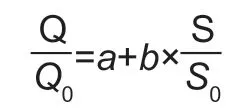
where,Q (MJ m−2d−1) is global solar radiation,Q0(MJ m−2d−1) is extraterrestrial solar radiation and total solar radiation of the ideal atmosphere,S is the actual sunshine hours in a day,andS0is the potential sunshine hours in a day.The constitute climatology coefficientsaandbare from Chenet al.(2004) as the extraterrestrial solar radiation and total solar radiation,respectively (Table 1).
The cumulative solar radiation (CSR) in the determined growth duration expressed as MJ m–2is calculated as:

where Q (MJ m–2d–1) is the daily global solar radiation.
Data are analyzed by analysis of variance (ANOVA) with SPSS 13.0 for Windows.The least significant difference(LSD) was used to test the significant differences between means at the 0.05 probability level.
3.Results
3.1.Effects of sowing date on the critical growth period
The whole growth duration (WGD) of both types of rice was shortened as the planting date was delayed (Appendix A),which was mainly manifested by the shortening of the number of days from sowing to heading.Compared with T1,the number of days from sowing to heading (S–H) in T2,T3,T4,T5,T6,and T7 were reduced by 1–3,3–6,6–9,10–13,13–17,and 17–21 d,respectively.
They challenged the conventional wisdom that sex determination in mammals is random, with parents investing equally in their offspring to generate a 50-50 sex ratio in the population
The heading and maturity dates of LMJR were later than those of MMJR for the same sowing dates,and LMJR had a longer WGD under the conditions of normal maturity (the percentage of yellow maturing grains was >90%).
3.2.Effects of sowing date on EAT,Tmean,SCR,and Rmean
As a result of delayed sowing dates,the EAT of both types of rice decreased in different growth stages (Table 2).The EAT of T1 for the WGD was 40.0–492.0°C d higher than that in the other treatments.
The same type of varieties (either LMJR or MMJR) had similar EATs in different growth stages.For different types of varieties,the EAT from S–H and for the WGD of MMJR were 65.3–97.7 and 15.9–49.4°C d lower than for LMJR,respectively,and the EAT from heading–maturity (H–M) was 35.1–68.3°C d higher than that of LMJR.
Tmeanin both types of rice from S–H increased with the delay of sowing date,and there were significant differences among the seven sowing dates (Table 3).Tmeanof T1 was 0.2–0.4,0.5–0.8,0.5–1.2,0.6–1.5,0.8–1.6,and 0.8–1.9°C lower than that in T2,T3,T4,T5,T6,and T7,respectively.Also,Tmeanof T1 from H–M and for the WGD were 0.9–5.0 and 0.2–1.7°C higher than in the other treatments,respectively.
Tmeanfor both types of rice in T1,T2,T3,and T4 were similar for the S–H duration.However,Tmeanof MMJR in T5,T6 and T7 were slightly higher than in LMJR.Tmeanof MMJR was 0.9–1.8 and 0.3–1.0°C higher than that of LMJR from H–M and for the WGD,respectively.
The CSR of both types of rice from S–H and for the WGD decreased with the delay of sowing date,and the difference in CSR for the same variety was significant in different treatments (Table 4).From H–M,the range of variation in CSR for the same rice variety during sowing was less than that between years.When the sowing date of LMJR varieties was later than T4,the CSR from H–M was higher than that in T2,T3 and T4.

Table 1 The coefficients a and b for each month in the Angstrom-Prescott Model
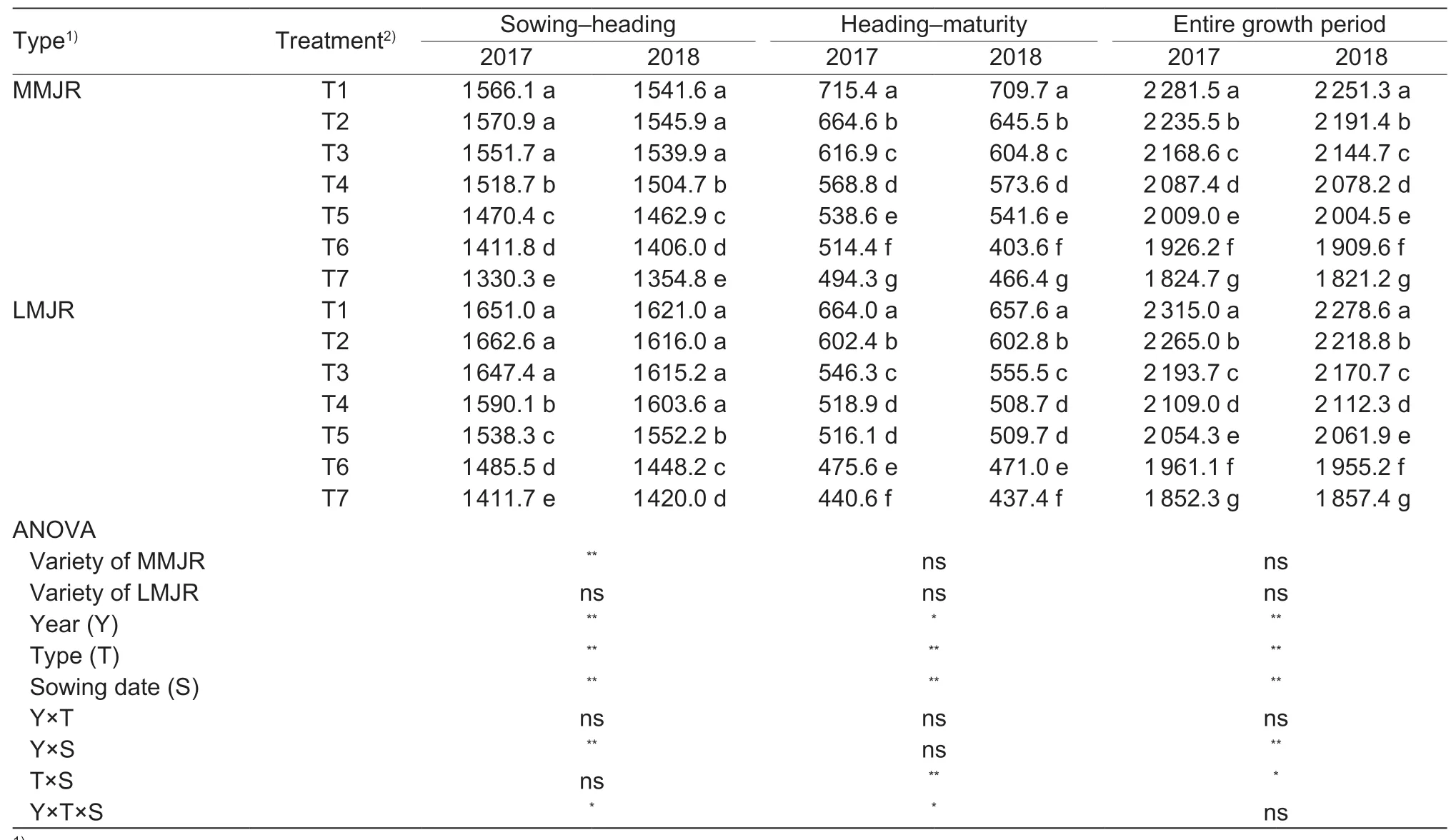
Table 2 Differences in effective accumulated temperature (EAT,°C d) of rice varieties in the seven environmental condition treatments
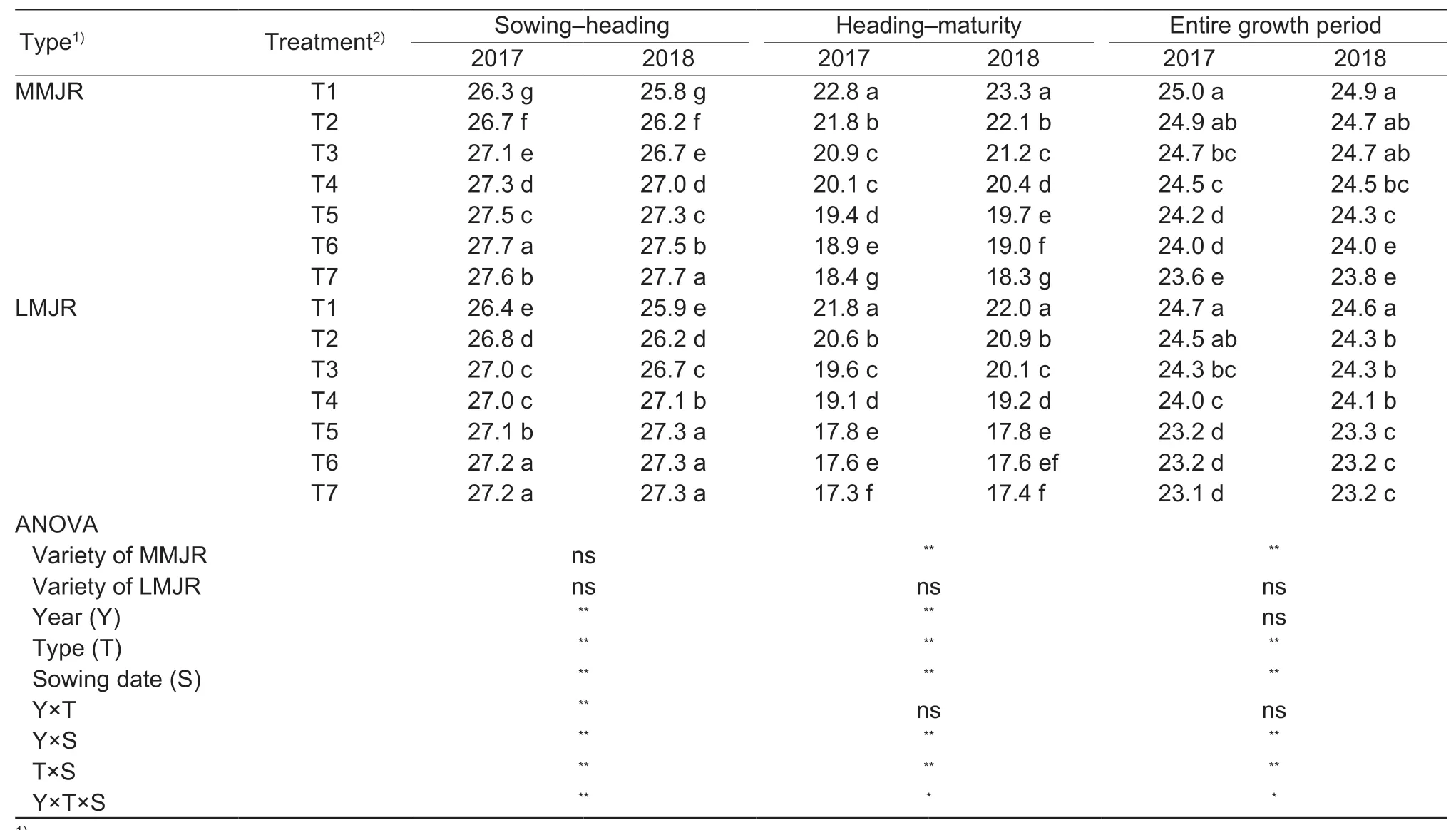
Table 3 Differences in mean daily temperature (Tmean,°C) of rice varieties in the seven environmental condition treatments
The CSR in MMJR from S–H and for the WGD were 62.9–118.3 and 40.1–195.9 MJ m−2lower than in LMJR,respectively.
Rmeanof both types of rice decreased with the delay of sowing date for S–H and the WGD (Table 5).The highestRmeanvalues for S–H and the WGD were 0.2–1.4 and 0.1–2.2 MJ m−2higher than those in the other treatments,respectively.Rmeanof MMJR for S–H and the WGD were 0.2–0.6 and 0.1–0.6 MJ m−2higher than thoes of LMJR,respectively.
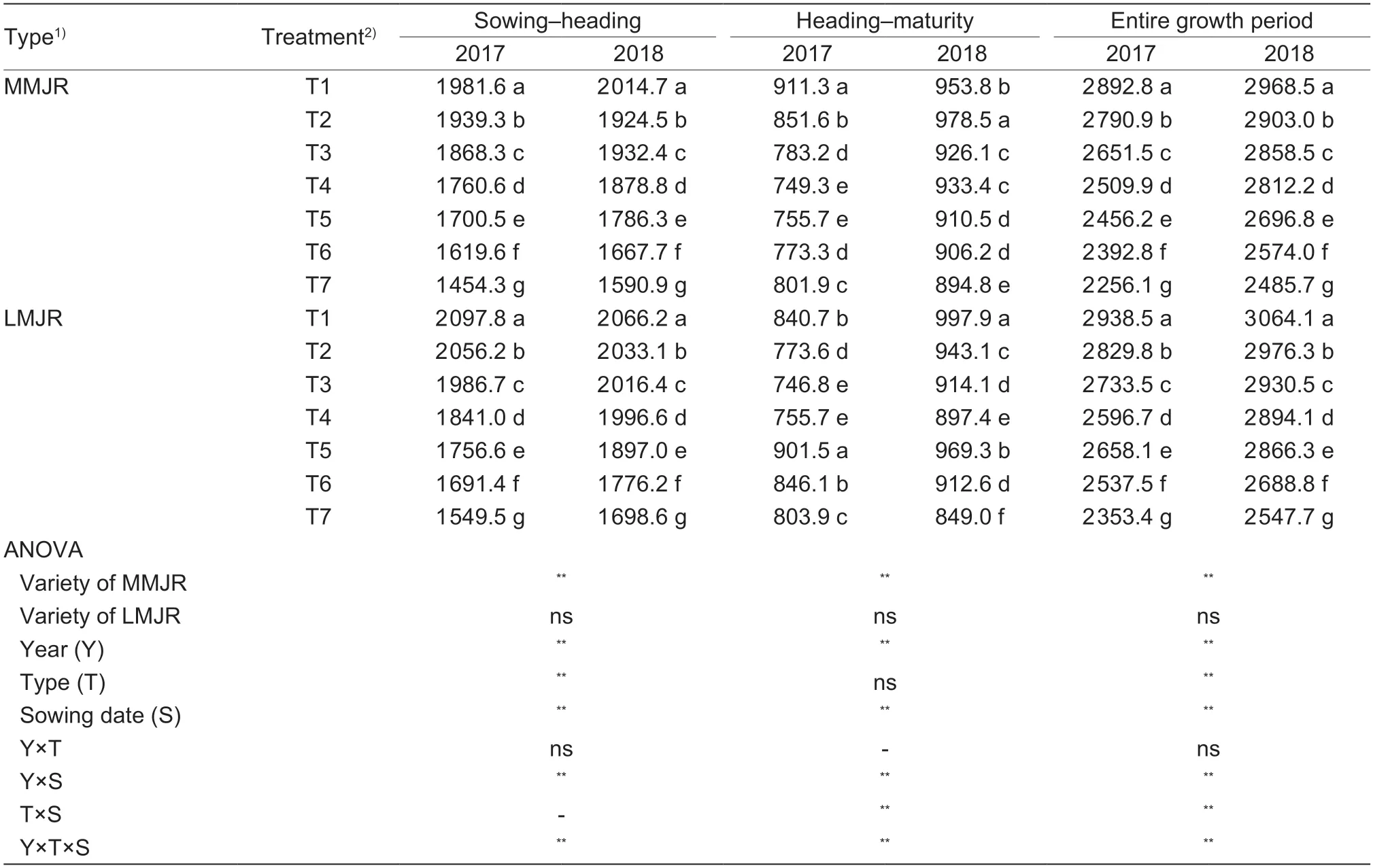
Table 4 Differences in cumulative solar radiation (CSR MJ m−2) of rice varieties in the seven environmental condition treatments
3.3.Effects of sowing date on rice yield
Yields of both types of rice decreased with the reductions in temperature and solar radiation (Table 6).Compared with T1,yields in T2,T3,T4,T5,T6,and T7 decreased by 0.12–0.35,0.45–0.89,0.74–1.56,1.41–2.24,2.16–2.90,and 2.69–3.64 t ha−1,respectively.The main factors that caused reduction in yield were the decreases in the number of panicles and the percentage of filled grains.
Yields of MMJR varieties in T1,T2,T3,and T4 were 0.04–0.57 t ha−1lower than those of LMJR;however,yields of MMJR in T5,T6 and T7 were 0.12–0.28 t ha−1higher than those of LMJR.
3.4.Correlation analysis of rice yield,temperature and solar radiation
Yield/EAT and yield/CSR reflect the utilization of temperature and solar radiation in rice.Yield/EAT and yield/CSR in T1,T2,T3,and T4 for both types of rice varieties were higher than those in T5,T6 and T7 (Figs.1 and 2).The relative yields showed a significantly positive correlation with EAT and CSR from S–H,and in addition,the relative yields also showed a significantly positive correlation with EAT,Tmean,CSR,andRmeanfrom H–M,but showed a negative correlation withTmeanfrom S–H (Figs.3–6).In the WGD,the relative yields showed a positive correlation with EAT,Tmean,CSR,andRmean.The correlation coefficient between yield and solar radiation was slightly less than that between yield and temperature.

Table 5 Differences in mean daily solar radiation (Rmean,MJ m−2 d−1) of rice varieties in the seven environmental condition treatments
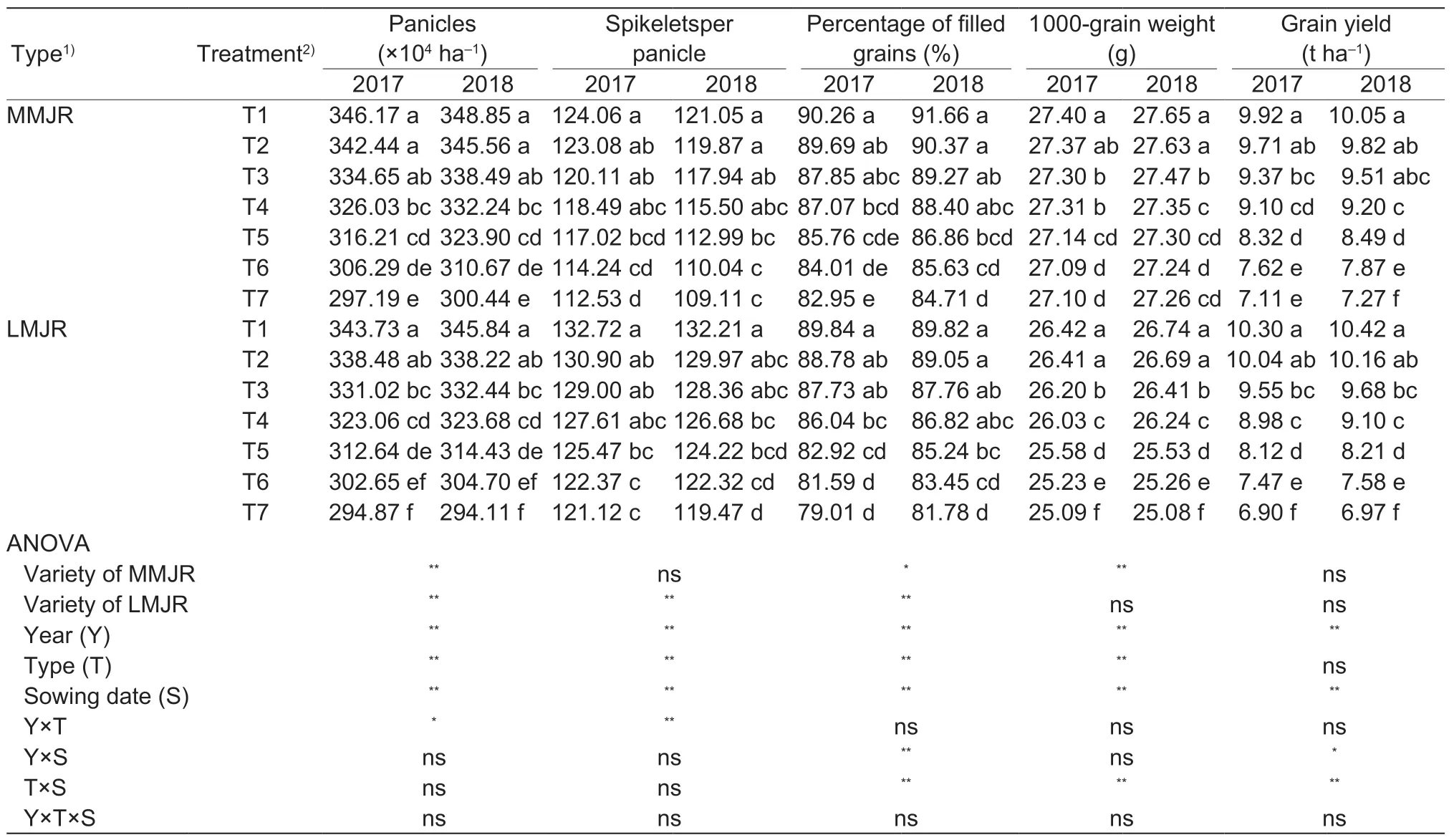
Table 6 Effects of temperature and solar solar radiation on grain yield (t ha−1) in high eating-quality rice varieties
When the relative yields of MMJR and LMJR are >1.0,the characteristics ofTmeanand EAT in the S–H period are shown in Table 7.
3.5.Optimum sowing date for high yield rice production
When rice seedlings experience temperatures lower than 10–12°C,they display symptoms of cold injury (Zenget al.2000;Wanget al.2005).Previous studies have shown that aTmeangreater than or equal to 10°C is the guaranteed temperature for normal growth of rice and other thermophilic crops (Shaet al.2002;Lüet al.2019).EAT reflects the heat situation during the growth period of crops,and it is often used as one of the indexes to evaluate and determine whether a variety or cultivation measure is suitable for local production (Wanget al.2008).In this experiment,the effective accumulated temperature was used to evaluate the suitability of temperature during the rice growth period.The date when the minimum temperature safely passed 10°C each year from 2007–2016 were taken as the starting dates to make statistics on the sowing date that meet the requirements for EAT at the different rice growth stages.The earliest sowing date for good eating-quality rice to obtain a relatively high yield was the same date when the daily minimum temperature safely exceeded 10°C(Table 8).The date when the daily minimum temperature safely passed 10°C in 2011 was significantly later than that in the other years,which led to the earliest suitable sowing date in 2011 being more than 7 d later than in the other years.The range of EAT from May to November in 2007–2018 was 2 283.7–2 515.5°C d,with an average value of 2 437.5°C d.The EATs in 2014 and 2015 were respectively 6.04 and 6.31% lower than the average EAT in 2007–2018,which resulted in the latest suitable sowing dates in 2014 and 2015 being more than 9 d earlier than in the other years (Fig.7).Hence,it is believed that the temperature conditions in 2011,2014 and 2015 were abnormal,and the suitable sowing dates determined from the other seven years were representative in the lower reaches of the Huai River.The earliest suitable sowing date for MMJR and LMJR in the lower reaches of the Huai River was May 15,and the latest sowing dates for MMJR and LMJR were May 31 and May 18,respectively.

Fig.1 The ratios of grain yield to effective accumulated temperature (EAT,g m−2 (°C d)−1) for the seven different sowing dates in 2017 and 2018.T1,T2,T3,T4,T5,T6,and T7 represent the sowing dates May 10,May 17,May 24,May 31,June 7,June 14,and June 21,respectively.MMJR,medium-maturing japonica rice;LMJR,late-maturing japonica rice.Vertical bars represent±standard error of the means of two MMJR varieties (n=2) and four LMJR varieties (n=4).
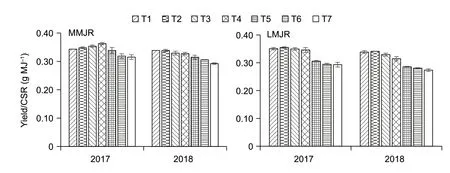
Fig.2 The ratios of grain yield to cumulative solar radiation (CSR,g MJ−1) for the seven different sowing dates in 2017 and 2018.T1,T2,T3,T4,T5,T6,and T7 represent the sowing dates May 10,May 17,May 24,May 31,June 7,June 14,and June 21,respectively.MMJR,medium-maturing japonica rice;LMJR,late-maturing japonica rice.Vertical bars represent ±standard error of the means of two MMJR varieties (n=2) and four LMJR varieties (n=4).
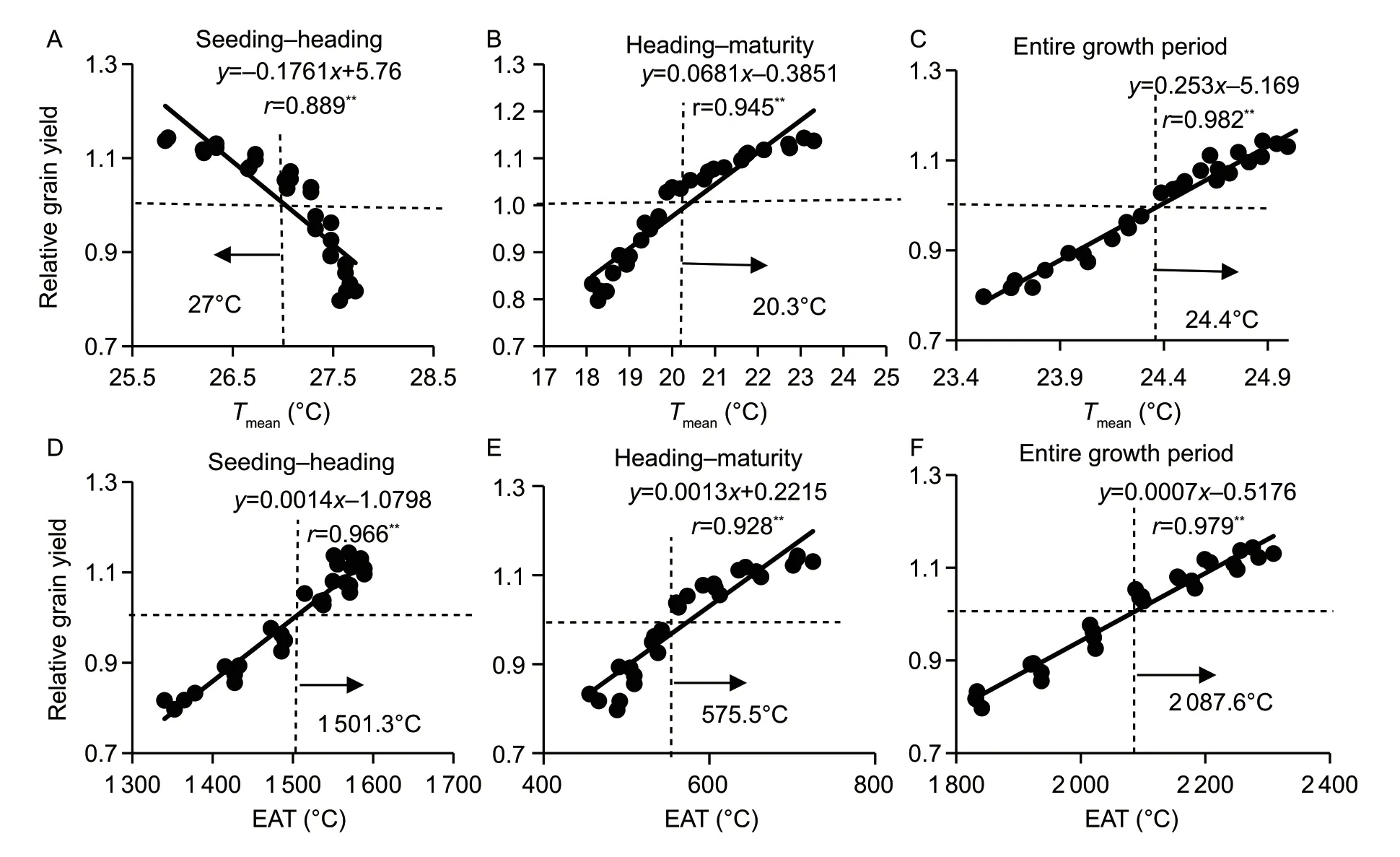
Fig.3 Correlations between yield and the mean daily temperature (Tmean) or effective accumulated temperature (EAT) for the medium-maturing japonica rice (MMJR) varieties in the seven sowing date treatments.A–C,Tmean in the seeding–heading stage(A),the heading–maturity stage (B) and the entire growth period (C).D–F,EAT in the seeding–heading stage (D),the heading–maturity stage (E) and the entire growth period (F).n=28.**,P<0.01 (0.478).
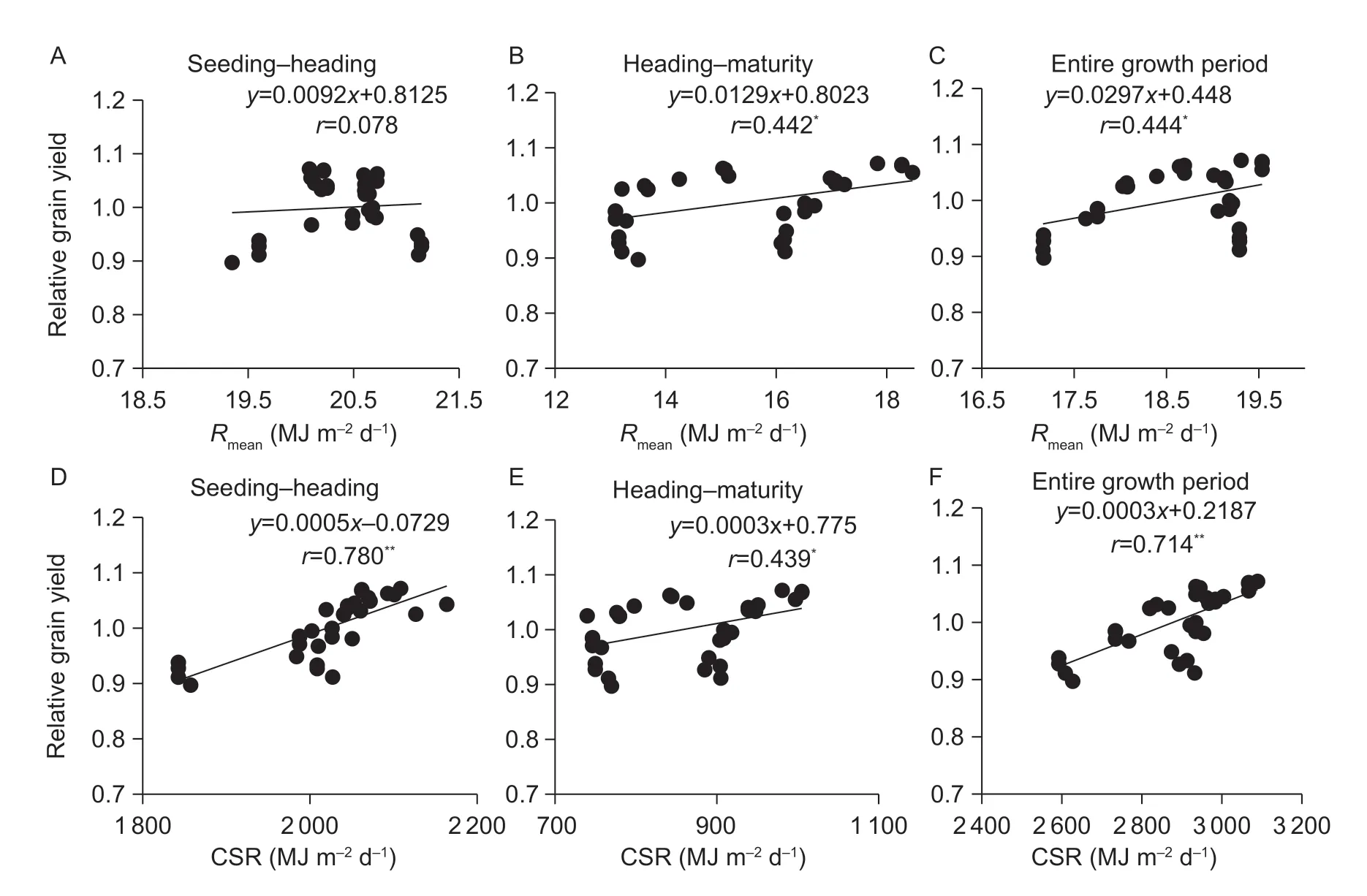
Fig.6 Correlations between yield and the mean daily solar radiation (Rmean) and cumulative solar radiation (CSR) for the latematuring japonica rice (LMJR) varieties in the seven sowing date treatments.A–C,Rmean in the seeding-heading stage (A),the heading–maturity stage (B) and the entire growth period (C).D–F,CSR in the seeding–heading stage (D),the heading–maturity stage (E) and the entire growth period (F).n=32.* and **,P<0.05 (0.349) and P<0.01 (0.449),respectively.
4.Discussion
4.1.Differences in effective accumulated temperature and cumulative solar radiation
Temperature and solar radiation are considered to be the main environmental factors that affect the yield potential in rice (Denget al.2015;Raoet al.2019).With delays in the sowing date,EAT and CSR for both types of rice decreased during the WGD,which was mainly due to the significant decrease in the S–H period.EAT or CSR depends on the length of the growing duration andTmeanorRmean.The Global Climate Models predict that rice maturity will be advanced by 11.0–14.7 days when temperature increases by 1.5–2.0°C(Guoet al.2019).Compared with T1,the number of days from sowing to heading for both types of rice in the other treatments is reduced by 1–21 d asTmeanincreases by 0.2–1.9°C.Hence,a significant reduction in the growth period from S–H due to a slight increase inTmeanresults in decreases in EAT and CSR.
Under the conditions of normal maturity,TmeanandRmeanof MMJR from S–H were similar to those of LMJR.However,EAT and CSR from S–H of MMJR were 65.3–97.7°C d and 62.9–118.3 MJ m−2lower than that of LMJR,respectively.The key growth date for MMJR was earlier than that of LMJR under the same sowing date,and the growth duration was shorter.Compared with MMJR,the longer growth period of LMJR was the main reason for the increase in EAT and CSR(Gonget al.2014;Huaet al.2014).
In summary,under conditions of normal maturity,for the same rice varieties,prolonging the growth period of rice by appropriate early sowing was beneficial to efficient utilizeation of temperature and light resources.For different rice varieties,choosing those with long growth periods was beneficial to efficient utilization of temperature and light resources.
4.2.Relationship between temperature and yield
Keeping temperature and solar radiation within a suitable range during the growth period of rice is conducive to the accumulation of biological and economic yield (Xinget al.2017;Wanget al.2020).The correlation analysis showed that temperature was the main factor that affects yield potential in rice in the lower reaches of the Huai River compared with solar radiation.The yields of six rice varieties showed significantly positive correlations with EAT,and significantly negative correlations withTmeanfrom S–H.Compared with T1,a slightly increasedTmeanof T2–T7 in theS–H period decreased the duration of rice tillering,which resulted in less EAT.The reduced EAT led to a decrease in the number of effective panicles,which was consistent with previous studies (Ma and Yanf 2015;Wanget al.2019).In the stages from H–M,both EAT andTmeanshowed a significantly positive correlation with yield.Compared with T1,EAT of T2–T7 was reduced by 53.6–255.5°C d due to a significant decrease inTmean.Also,a decreased EAT caused a decline in seed-setting rate.Therefore,thanks to the delay in sowing date,reduced effective panicles and seed-setting rate resulted in a reduced yield.

Table 7 Temperature characteristics at different growth stages of rice with relative yield greater than one1)

Table 8 Suitable sowing dates to obtain high yields of rice with good eating quality in the 10-year period from 2007 to 2016 (mon/d)1)
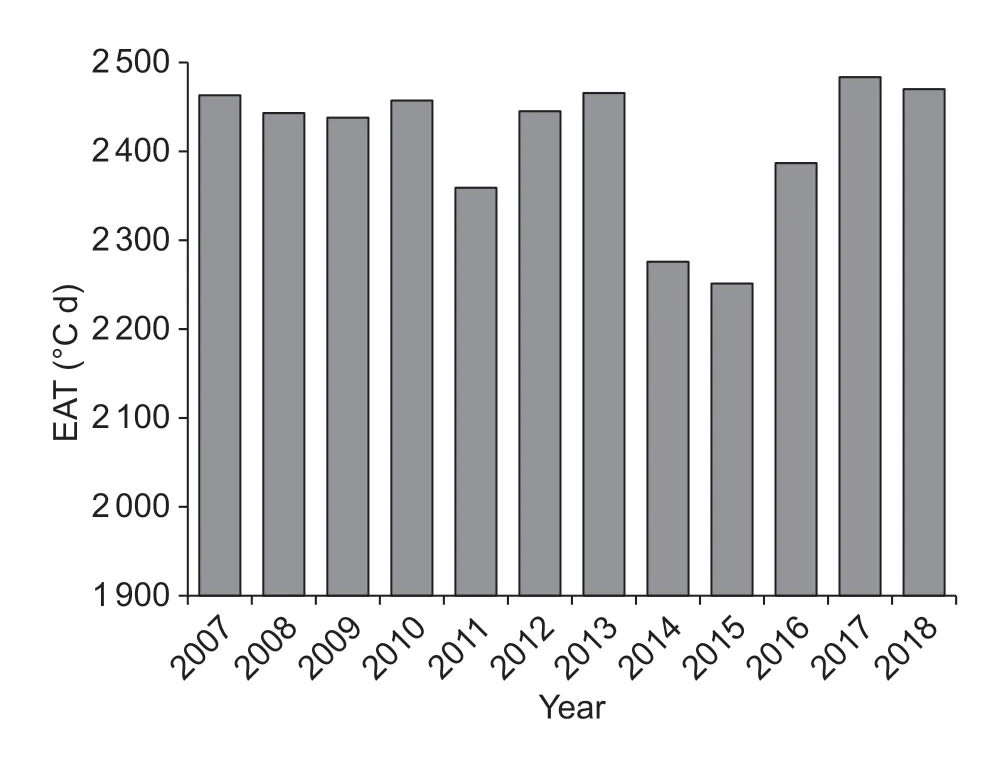
Fig.7 Differences of effective accumulated temperature(EAT,°C d) from May to November in 2007–2018.
Yield of LMJR was slightly higher than that of MMJR in treatments T1,T2,T3,and T4,which was due to the higher number of spikelets per panicle.Previous researches suggest that a longer growth duration is linked with greater effective cumulative temperature and consequently higher grain yield (Yinget al.1998;Sunet al.2015).Compared with MMJR,the higher number of spikelets per panicle in LMJR may be due to the abundant EAT from S–H.However,under the conditions of T5,T6 and T7,the lowTmeanduring grain filling significantly reduced the seed-setting rate of LMJR,and the continuous low temperature after heading hindered the distribution of assimilates to the grains (Huanget al.2020).Therefore,lower seed-setting rate and 1 000-grain weight resulted in a reduced yield in LMJR.
4.3.Recommendations on suitable sowing date ranges for rice
The main cropping systems in the lower reaches of the Huai River include rice–wheat,rice–vegetable,rice–oilseed rape,and rice–green manure.The rice–wheat rotation system accounts for more than 90% of all the planting area in the lower reaches of the Huai River (data.cnki.net/area/Yearbook/Single/N2018110013?z=D10).The annual sowing time for winter wheat is from October 15 to November 10,and the crop is harvested from June 1 to June 15 (Jianget al.2016;Ji and Shi 2018).Considering the time of harvesting,land preparation and other agricultural consumption,the growth and utilization date of rice can be planted by carpet seeding of mechanical transplanting under the rice–wheat rotation system is from May 16 to November 5.Therefore,the sowing date ranges for relatively high yields of MMJR and LMJR are May 16–31 and May 16–18,respectively.The rice–vegetable and rice–oilseed rape rotation systems account for 5% of the rotation systems by planting area in the lower reaches of the Huai River,and the rice-green manure crop rotation accounts for less than 1%.Harvest times for the vegetable,oilseed rape,or green manure rotations are 10–15 days earlier than that of wheat (Shiet al.2014).In order to ensure that rice does not suffer from low temperatures in the seedling stage,the suitable sowing date range for relatively high yields of MMJR and LMJR in the rice–vegetable,rice–oilseed rape rotation systems and rice–green manure crop rotation are May 15–31 and May 15–18,respectively.
In conclusion,under the main cropping systems,May 15–31 and May 15–18 were found to be the optimal sowing dates for MMJR and LMJR,respectively,to obtain relatively high yields in the lower reaches of the Huai River.
5.Conclusion
Compared with solar radiation,temperature is the main environmental factor that affects the yield of good eatingquality rice in the lower reaches of the Huai River.With the delay in sowing date,yields of MMJR and LMJR showed a significant decrease along with a decline in EAT.For the same sowing dates,yield of LMJR was slightly higher than that of MMJR.Compared with MMJR,LMJR had more spikelets per panicle due to its higher EAT from S–H.Based on the requirement of temperature to obtain relatively high yields,the optimal sowing dates recommended for MMJR and LMJR are May 15–31 and May 15–18,respectively.
Acknowledgements
This research was funded by the National Key R&D Program of China (2016YFD0300503),the earmarked fund for China Agriculture Research System (CARS0127),the National Natural Science Foundation of China (31971841),the Key Research Program of Jiangsu Province,China (BE2018355),the earmarked fund for Jiangsu Agricultural Industry Technology System,China (JATS[2020]450),and the Project Funded by the Priority Academic Program Development of Jiangsu Higher Education Institutions,China.
Declaration of competing interest
The authors declare that they have no conflict of interest.
Appendixassociated with this paper is available on http://www.ChinaAgriSci.com/V2/En/appendix.htm
杂志排行
Journal of Integrative Agriculture的其它文章
- Receptor-like kinase OsASLRK regulates methylglyoxal response and content in rice
- Heredity and gene mapping of a novel white stripe leaf mutant in wheat
- Construction of a high-density adzuki bean genetic map and evaluation of its utility based on a QTL analysis of seed size
- Difference in corn kernel moisture content between pre-and postharvest
- The effect of elevating temperature on the growth and development of reproductive organs and yield of summer maize
- High plant density increases seed Bt endotoxin content in Bt transgenic cotton
